Students get through the TN Board 11th Bio Botany Important Questions Chapter 14 Respiration which is useful for their exam preparation.
TN State Board 11th Bio Botany Important Questions Chapter 14 Respiration
Very short answer questions
Question 1.
Define the term Respiration.
Answer:
During the night, plants take up oxygen and release carbon dioxide and as a result, carbon dioxide will be abundant around the tree. This process of CO2 evolution is called respiration.
Question 2.
What do you mean by Respiratory substrate? Give example.
Answer:
Respiration is a biological process in which oxidation of various food substances like carbohydrates, proteins, and fats take place and as a result of this, energy is produced where O2 is taken in and CO2 is liberated. The organic substances which are oxidised during respiration are called respiratory substrates.
Question 3.
Write the overall equation of respiration.
Answer:
C6H12O6 + 6O2 → 6CO2 + 6H2O + Energy
(686 K cal or 2868 KJ)
![]()
Question 4.
How Blackman classified respiration? Name them.
Answer:
Depending upon the nature of respiratory substrate, Blackman divided respiration into,
- Floating respiration and
- Protoplasmic respiration.
Question 5.
Compensation point – Define.
Answer:
At dawn and dusk, the intensity of light is low. The point at which CO2 released in respiration is exactly compensated by CO2 fixed in photosynthesis that means no net gaseous exchange takes place, it is called the compensation point. At this moment, the amount of oxygen released from photosynthesis is equal to the amount of oxygen utilized in respiration. The two common factors associated with the compensation point are CO2 and light (Figure 14.2). Based on this there are two types of compensation points. They are CO2 compensation point and light compensation point. C3 plants have compensation points ranging from 40-60 ppm (parts per million) CO2 while those of C4 plants range from 1-5 ppm CO2.
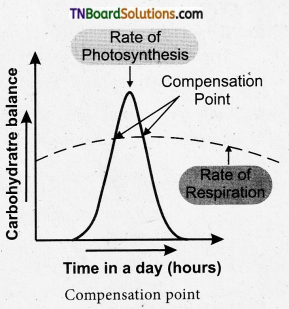
Question 6.
Name the types of compensation points.
Answer:
(a) CO2 compensation point, (b) Light compensation point.
![]()
Question 7.
ATP is the universal energy currency of the cell – Justify.
Answer:
Respiration is responsible for the generation of ATP. The discovery of ATP was made by Karl Lohman (1929). ATP is a nucleotide consisting of a base-adenine, a pentose sugar-ribose, and three phosphate groups. Out of three phosphate groups, the last two are attached by high-energy-rich bonds (Figure 14.3). On hydrolysis, it releases energy (7.3 Kcal or 30.6 KJ/ATP) and it is found in all living cells and hence it is called the universal energy currency of the cell. ATP is an instant source of energy within the cell. The energy contained in ATP is used in Lipman (1941).
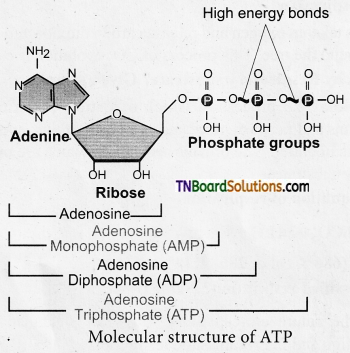
Question 8.
Who discovered ATP? Name any two other high-energy compounds in the cell similar to ATP?
Answer:
ATP was discovered by Karl Lohman in 1929. GTP (Guanosine Triphosphate), UTP (Uridine Triphosphate) are some other energy-rich compounds in the cell.
Question 9.
Expand the term (a) ATP, (b) ADP.
Answer:
AMP – Adenosine Monophosphate, ADP – Adenosine Diphosphate.
Question 10.
Compare Aerobic respiration with anaerobic respiration.
Answer:
| Aerobic Respiration | Anaerobic Respiration |
| Respiration occurs in the presence of oxygen. | Respiration occurs in the absence of oxygen. |
| It occurs to all higher plants and animals. | It occurs in microorganisms like yeast. |
![]()
Question 11.
Mention the stages of aerobic respiration.
Answer:
- Glycolysis-conversion of glucose into pyruvic acid in the cytoplasm of the cell.
- Link reaction-conversion of pyruvic acid into acetyl coenzyme-A in the mitochondrial matrix.
- Krebs cycle-conversion of acetyl coenzyme A into carbon dioxide and water in the mitochondrial matrix.
Question 12.
Where does glycolysis occur? Mention the scientists who described it?
Answer:
Glycolysis occurs in the cytoplasm of the cell. Glycolysis was described by Gustav Embden, Otto Meyerhoff, and J. Pamas.
Question 13.
Mention the two phases of Glycolysis.
Answer:
(a) Preparatory phase or hexose phase, (b) Pay off phase or triose phase.
Question 14.
Define Glycolysis.
Answer:
Glycolysis: (Gr: Glykos 5 Glucose, Lysis 5 Splitting) Glycolysis is a linear series of reactions in which 6-carbon glucose is split into two molecules of 3-carbon pyruvic acid. The enzymes which are required for glycolysis are present in the cytoplasm (Figure 14.6). The reactions of glycolysis were worked out in yeast cells by three scientists Gustav Embden (German), Otto Meyerhoff (German), and J Parnas (Polish) and so it is also called as EMP pathway.
Question 15.
What is Substrate/Trans-phosphorylation?
Answer:
The direct transfer of phosphate moiety from substrate molecule to ADP and is converted into ATP is called substrate phosphorylation or direct phosphorylation or trans-phosphorylation.
![]()
Question 16.
Define the term Enolation.
Answer:
In glycolysis, at step nine, 2-phosphoglycerate is dehydrated into phosphoenol pyruvate by the enzyme enolase. As a result, an enol group is formed within the molecule. This process is called enolation.
Question 17.
List the products of Glycolysis.
Answer:
(a) Pyruvic acid (2 molecules), (b) 2 ATP molecules and (c) 2 NADH, molecules.
Question 18.
Who discovered the TCA cycle? Where does it occur?
Answer:
The tricarboxylic Acid (TCA) cycle was discovered by Sir Hans Adolf Krebs in 1937. TCA cycle occurs in the mitochondrial matrix.
Question 19.
Draw the structure of oxysomes.
Answer:
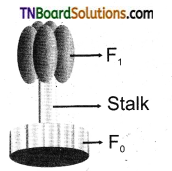
Question 20.
Why TCA cycle is called so?
Answer:
TCA cycle starts with the condensation of acetyl CoA with oxaloacetate in the presence of water to yield citrate or citric acid. Therefore, it is also known as the citric acid Cycle (CAC) or Tri Carboxylic Acid (TCA) cycle.
![]()
Question 21.
Krebs cycle is an amphibolic pathway – Comment.
Answer:
The Krebs cycle is primarily a catabolic pathway, but it provides precursors for various biosynthetic pathways thereby an anabolic pathway too. Hence, it is called the amphibolic pathway. It serves as a pathway for the oxidation of carbohydrates, fats, and proteins.
Question 22.
Mention the four multi-protein complexes in ETC.
Answer:
(a) Complex – I – NADH dehydrogenase
(b) Complex – II – Succinic dehydrogenase
(c) Complex – III – Cytochrome be, complex
(d) Complex – IV – Cytochrome c oxidase
Question 23.
Write a brief note on Ubiquinone.
Answer:
Ubiquinone and cytochrome bc1, the complex is structurally and functionally similar to plastoquinone and cytochrome b6, f complex respectively in the photosynthetic electron transport chain.
Question 24.
Mitochondria are called powerhouses of the cell. Why?
Answer:
Complete oxidation of a glucose molecule in aerobic respiration results in the net gain of 36 ATP molecules in plants. Since a huge amount of energy is generated in mitochondria in the form of ATP molecules they are called the powerhouse of the cell. In the case of aerobic prokaryotes due to lack of mitochondria, each molecule of glucose produces 38 ATP molecules.
Question 25.
Name any two ETC inhibitors.
Answer:
2, 4 DNP – cyanide.
Question 26.
Define Respiratory Quotient.
Answer:
The ratio of the volume of carbon dioxide given out and the volume of oxygen taken in during respiration is called Respiratory Quotient or Respiratory ratio. RQ value depends upon respiratory substrates and their oxidation.

![]()
Question 27.
Calculate the respiratory quotient for the following equation.
C6H12O6 → 2CO22 + 2C2H5OH + Energy
Answer:
Volume of O2 used = O. Volume of CO2 released = 2
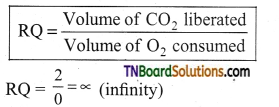
Question 28.
What is the significance of the respiratory quotient?
Answer:
Significance of RQ
- RQ value indicates which type of respiration occurs in living cells, either aerobic or anaerobic.
- It also helps to know which type of respiratory substrate is involved.
Question 29.
Define fermentation and mention its types.
Answer:
Some organisms can respire in the absence of oxygen. This process is called fermentation or anaerobic respiration. There are three types of fermentation:
- Alcoholic fermentation
- Lactic acid fermentation
- Mixed acid fermentation
Question 30.
Give an account on lactic acid fermentation.
Answer:
Some bacteria (Bacillus), fungi and muscles of vertebrates produce lactic acid from pyruvic acid:
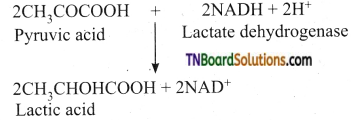
Question 31.
Observe the given diagram given below and answer the questions.
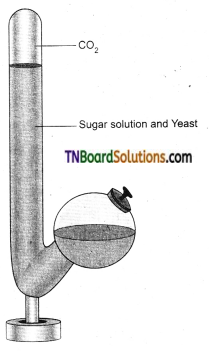
(a) Name the apparatus set up.
(b) Mention the purpose of the apparatus.
Answer:
(a) The apparatus set up is Kuhne’s fermentation tube.
(b) Kuhne’s fermentation tube is used to demonstrate alcoholic fermentation.
![]()
Question 32.
Name the scientists who discovered HMP shunt. Also, expand the term HMP shunt.
Answer:
HMP shunt refers to Hexose Monophosphate shunt which was discovered by Warburg, Dickens, and Lipmann.
Short answer questions
Question 1.
Compare floating respiration with protoplasmic respiration.
Answer:
| S. No. | Floating Respiration | Protoplasmic Respiration |
| a. | Carbohydrates, fat, or organic acids act as respiratory substrates. | Protein acts as a respiratory substrate. |
| b. | It does not produce any toxic product. | It produces toxic ammonia and also depletes structural and functional proteins of protoplasm. |
| c. | It is a common mode of respiration. | It is a rare form of respiration. |
Question 2.
Draw the structure of an ATP molecule.
Answer:
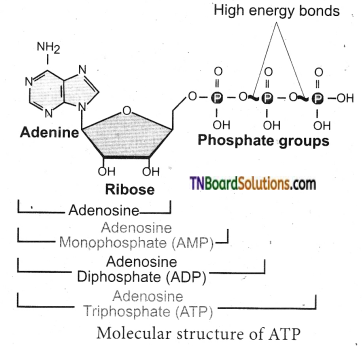
Question 3.
Describe the structure of ATP.
Answer:
Respiration is responsible for the generation of ATP. The discovery of ATP was made by Karl Lohman (1929). ATP is a nucleotide consisting of a base-adenine, a pentose sugar-ribose, and three phosphate groups.
Out of three phosphate groups, the last two are attached by high-energy-rich bonds (Figure 14.3). On hydrolysis, it releases energy (7.3 Kcal or 30.6 KJ/ATP) and it is found in all living cells and hence it is called the universal energy currency of the cell. ATP is an instant source of energy within the cell. The energy contained in ATP is used in the synthesis of carbohydrates, proteins, and lipids. The energy transformation concept was established by Lipman (1941).
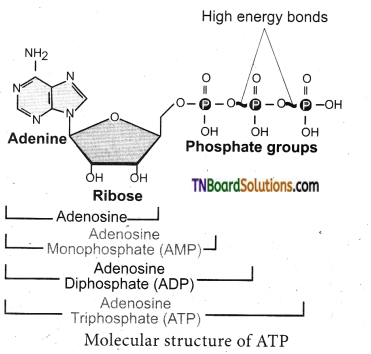
![]()
Question 4.
How Redox reaction occurs in NADH2 and FADH2.
Answer:
NAD+ + 2e+ + 2H+ → NADH + H+
FAD + 2e– + 2H+ → FADH2
When NAD+ (Nicotinamide Adenine Dinucleotide-oxidised form) and FAD (Flavin Adenine Dinucleotide) pick up electrons and one or two hydrogen ions (protons), they get reduced to NADH + H+ and FADH2 respectively. When they drop electrons and hydrogen off they go back to their original form. The reaction in which NAD+ and FAD gain (reduction) or lose (oxidation) electrons is called redox reaction (Oxidation-reduction reaction). These reactions are important in cellular respiration.
Question 5.
Explain simply the stages of respiration.
Answer:
Stages of Respiration:
- Glycolysis-conversion of glucose into pyruvic acid in the cytoplasm of the cell.
- Link reaction-conversion of pyruvic acid into acetyl coenzyme-A in the mitochondrial matrix.
- Krebs cycle-conversion of acetyl coenzyme A into carbon dioxide and water in the mitochondrial matrix.
- Electron transport chain and oxidative phosphorylation remove hydrogen atoms from the products of glycolysis, link reaction, and Krebs cycle release water molecule with energy in the form of ATP in the mitochondrial inner membrane.
Question 6.
Write the overall equation for glycolysis.
Answer:

Question 7.
Give an account of pyruvic oxidation.
Answer:
Two molecules of pyruvate formed by glycolysis in the cytosol enter into the mitochondrial matrix. In aerobic respiration, this pyruvate with coenzyme A is oxidatively decarboxylated into acetyl CoA by pyruvate dehydrogenase complex. This reaction is irreversible and produces two molecules of NADH + H+ and 2CO2. It is also called transition reaction or Link reaction. The reaction of pyruvate oxidation is

![]()
Question 8.
Draw and label the structure of mitochondria.
Answer:
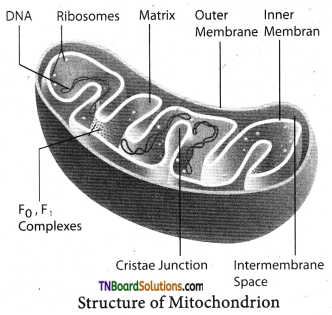
Question 9.
How fats and protein enter the Krebs cycle?
Answer:
When fats are a respiratory substrate they are first broken down into glycerol and fatty acid. Glycerol is converted into DHAP and acetyl CoA. This acetyl CoA enters into the Krebs cycle. When proteins are the respiratory substrate they are degraded into amino acids by proteases. The amino acids after deamination enter into the Krebs cycle through pyruvic acid or acetyl CoA and it depends upon the structure.
Question 10.
Mention the types of electron transport chain inhibitors and their action.
Answer:
Electron transport chain inhibitors:
- 2,4 DNP (Dinitrophenol) – It prevents the synthesis of ATP from ADP, as it directs electrons from Co Q to Q2
- Cyanide – It prevents the flow of electrons from Cytochrome a3 to O2
- Rotenone – It prevents the flow of electrons from NADH + H+ / FADH2 to Co Q
- Oligomycin – It inhibits oxidative phosphorylation.
![]()
Question 11.
Give a brief account of Alcoholic fermentation.
Answer:
The cells of roots in waterlogged soil respire by alcoholic fermentation because of lack of oxygen by converting pyruvic acid into ethyl alcohol and CO2. Many species of yeast (Saccharomyces) also respire anaerobically.
This process takes place in two steps:

Question 12.
List out the industrial uses of alcoholic fermentation.
Answer:
- In bakeries, it is used for preparing bread, cakes, biscuits.
- In beverage industries for preparing wine and alcoholic drinks.
- In producing vinegar and in tanning, curing of leather.
- Ethanol is used to make gasohol (a fuel that is used for cars in Brazil).
Question 13.
Enumerate the characteristics of anaerobic respiration.
Answer:
- Anaerobic respiration is less efficient than aerobic respiration.
- a Limited number of ATP molecules is generated per glucose molecule.
- It is characterized by the production of CO2 and is used for Carbon fixation in photosynthesis.
Question 14.
Give a comparative study on glycolysis and fermentation.
Answer:
Comparison between glycolysis and fermentation:
| Glycolysis | Fermentation |
| Glucose is converted into pyruvic acid. | Starts from pyruvic acid and is converted into alcohol or lactic acid. |
| It takes place in the presence or absence of oxygen. | It takes place in the absence of oxygen. |
| Net gain is 2ATP. | No net gain of ATP molecules. |
| 2NADH + H+ molecules are produced. | 2NADH + H+ molecules are utilized. |
![]()
Question 15.
Point out the importance of the pentose phosphate pathway.
Answer:
- HMP shunt is associated with the generation of two important products, NADPH and pentose sugars, which play a vital role in anabolic reactions.
- Coenzyme NADPH generated is used for reductive biosynthesis and counter damaging the effects of oxygen free radicals
- Ribose-5-phosphate and its derivatives are used in the synthesis of DNA, RNA, ATP, NAD+, FAD, and Coenzyme A.
- Erythrose is used for the synthesis of anthocyanin, lignin, and other aromatic compounds.
Long answer questions
Question 1.
Explain the phases of glycolysis.
Answer:
1. Preparatory phase: Glucose enters the glycolysis from sucrose which is the end product of photosynthesis. Glucose is phosphorylated into glucose-6- phosphate by the enzyme hexokinase and subsequent reactions are carried out by different enzymes. At the end of this phase fructose-1, 6 – bisphosphate is cleaved into glyceraldehyde-3- phosphate and dihydroxyacetone phosphate by the enzyme aldolase. These two are isomers. Dihydroxyacetone phosphate is isomerized into glyceraldehyde-3- phosphate by the enzyme triosephosphate isomerase, now’ two molecules of glyceraldehyde 3 phosphate enter into pay off phase. During the preparatory phase, two ATP molecules are consumed in step-1 and step-3.
2. Pay-off phase: Two molecules of glyceraldehyde-3- phosphate oxidatively phosphorylated into two molecules of 1,3 – bisphosphate glycerate. During this reaction, 2NAD+ is reduced to 2NADH + H+ by glyceraldehyde- 3- phosphate dehydrogenase at step 6. Further reactions are carried out by different enzymes and at the end, two molecules of pyruvate are produced. In this phase, 2ATPs are produced at step 7 and 2 ATPs at step 10. The direct transfer of phosphate moiety from substrate molecule to ADP and is converted into ATP is called substrate phosphorylation or direct phosphorylation or transphosphorylation. During the reaction at step 9, 2phospho glycerate dehydrated into Phospho enol pyruvate a water molecule is removed by the enzyme enolase. As a result, the enol group is formed within the molecule. This process is called Enolation.
Question 2.
Draw a Flow chart depicting the steps of glycolysis.
Answer:
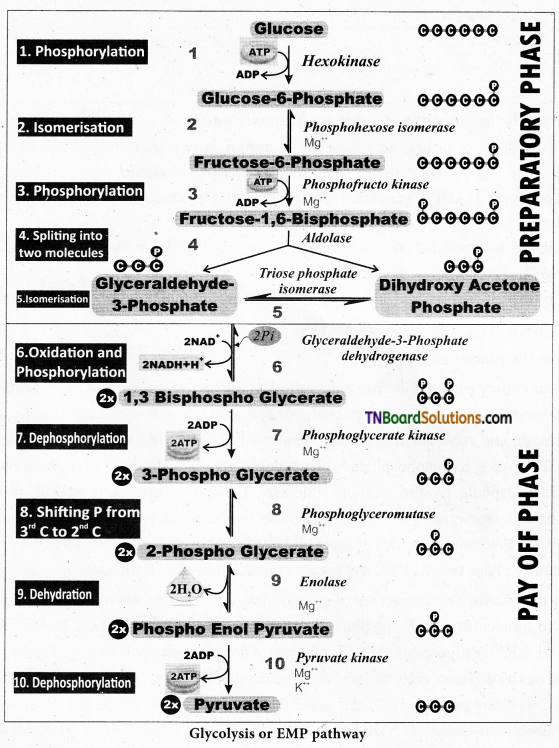
![]()
Question 3.
Point out the significance of Kreb’s Cycle.
Answer:
Significance of Krebs cycle:
- TCA cycle is to provide energy in the form of ATP for metabolism in plants.
- It provides carbon skeleton or raw material for various anabolic processes.
- Many intermediates of the TCA cycle are further metabolized to produce amino acids, proteins, and nucleic acids.
- Succinyl CoA is the raw material for the formation of chlorophylls, cytochrome, phytochrome, and other pyrrole substances.
- α-ketoglutarate and oxaloacetate undergo reductive animation and produce amino acids.
- It acts as a metabolic sink which plays a central role in intermediary metabolism.
Question 4.
Draw a Flow chart of Kreb’s cycle.
Answer:
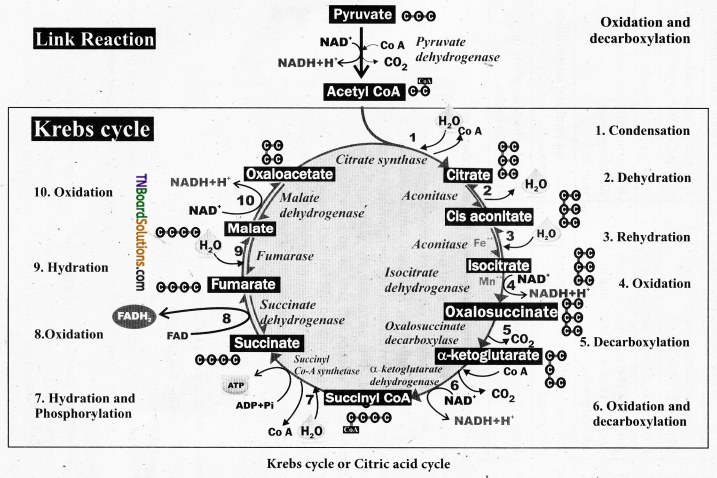
Question 5.
Compare alcoholic fermentation with lactic acid fermentation.
Answer:
Comparison of alcoholic fermentation and lactic acid fermentation
| Alcoholic fermentation | Lactic acid fermentation |
| It produces alcohol and releases CO2 from pyruvic acid. | It produces lactic acid and does not release CO2 from pyruvic acid. |
| It takes place in two steps. | It takes place in a single step. |
| It involves two enzymes, pyruvate decarboxylase with Mg+ + and alcohol dehydrogenase. | It uses one enzyme, lactate dehydrogenase with Zn+ +. |
| It forms acetaldehyde as an intermediate compound. | Does not form an intermediate compound. |
| It commonly occurs in yeast. | Occurs in bacteria, some fungi and vertebrate muscles. |
![]()
Question 6.
Demonstrate alcoholic fermentation using Kuhne’s apparatus.
Answer:
Demonstration of alcoholic fermentation:
Take a Kuhne’s fermentation tube which consists of an upright glass tube with a side bulb. Pour 10% sugar solution mixed with baker’s yeast into the fermentation tube the side tube is filled plug the mouth with a lid. After some time, the glucose solution will be fermented. The solution will give out an alcoholic smell and the level of solution in the glass column will fall due to the accumulation of CO2 gas. It is due to the presence of the zymase enzyme in yeast which converts the glucose solution into alcohol and CO2. Now introduce a pellet of KOH into the tube, the KOH will absorb CO2, and the level of solution will rise in the upright tube.
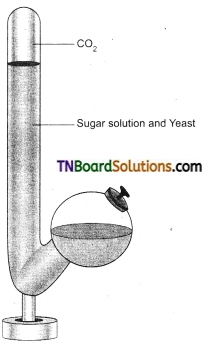
Question 7.
What are the factors that affect respiration?
Answer:
Factors Affecting Respiration Answer: Internal Factors
- The amount of protoplasm and its state of activity influence the rate of respiration.
- The concentration of respiratory substrate is proportional to the rate of respiration.
External Factors
- Wounding of plant organs stimulates the rate of respiration in that region.
- Some chemical substance acts as inhibitors. Example: Cyanides.
- Rate of respiration decreases with decreasing amount of water. Proper hydration is essential for respiration.
- Light is an indirect factor affecting the rate of respiration.
- The optimum temperature for respiration is 30°C. At low temperatures and very high temperatures rate of respiration decreases.
- When a sufficient amount of O2 is available the rate of aerobic respiration will be optimum and anaerobic respiration is completely stopped. This is called the Extinction point.
- A high concentration of CO2 reduces the rate of respiration.
- A plant or tissue transferred from water to salt solution will increase the rate of respiration. It is called salt respiration.
![]()
Higher Order Thinking Skills (HOTs)
Question 1.
Glycolysis and Kreb’s cycle both are energy-yielding pathways in aerobic respiration. How these two pathways differ among themselves?
Answer:
| Glycolysis | Krebs Cycle |
| It occurs in the cytoplasm. | It occurs in mitochondria. |
| CO2 is not released. | CO2 is released. |
| Linear pathway consisting of nine steps. | Cyclic pathway consisting of eight steps. |
| End products are two molecules of pyruvic acid. | End products are CO2 and H2O and energy molecules. |
Question 2.
Anaerobic respiration is usually noticed in lower organisms. A human being is an advanced organism whether anaerobic respiration occurs in a man? If so when and where does it takes place.
Answer:
Yes, anaerobic respiration occurs man at certain cases. Anaerobic respiration (lactic acid fermentation) occurs in the muscle cells of man during heavy exercise, continuous workouts running, etc.
Question 3.
Complete the formula of the respiratory quotient by naming A and B. Also, mention what type of substrate have a respiratory question of 1 and > 1?
Respiratory Quotient = \(\frac{A}{B}\)
Answer:

Respiratory Quotient will be equal to unity if the substrate is a carbohydrate.
Respiratory Quotient will be more than unity if the substrate is an organic acid.
Question 4.
The Flow Chart given below depicts the preparatory phase of the glycolysis pathway. Complete it by filling the missing steps A, B, C and also indicate whether ATP is being used up or released at Step D.
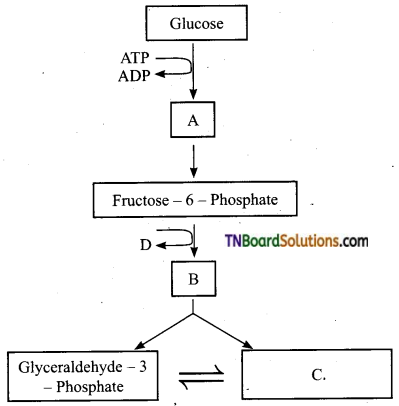
Answer:
A = Glucose – 6 – Phosphate.
B = Fructose -1,6- Bisphosphate.
C = Dihydroxy Acetone Phosphate.
In step D, ATP is utilized to phosphorylate Fructose – 6 – phosphate to Fructose —1,6 — Bisphosphate.
![]()
Question 5.
The energy yield in terms of ATP is higher in aerobic respiration than during anaerobic respiration – Discuss.
Answer:
In aerobic respiration, oxidation of one molecule of glucose generates 36 ATP molecules. On the other hand, during anaerobic respiration, the glucose is incompletely oxidized producing only 2 ATP molecules. Thus it is clear that aerobic respiration is more ATP beneficial than anaerobic respectively.
Question 6.
Answer the following questions in concern with the TCA cycle.
(a) Where does it take place?
(b) When and by whom it was discovered?
(c) Name the first formed product of the cycle.
(d) How many ATP molecules are generated per cycle?
(e) TCA cycle is an amphibolic pathway. Say yes or no. Why?
Answer:
(a) TCA cycle takes place in mitochondrion.
(b) TCA cycle was discovered by Sir Hans Adolf Krebs in 1937.
(c) The first formed product of the TCA cycle is citric acid or citrate.
(d) Only one ATP molecule is generated per TCA cycle.
(e) Yes. TCA is an amphibolic pathway because it involves both anaerobic and catabolic reactions.
Question 7.
Mention the fate of pyruvic acid in a cell, under the given circumstances.
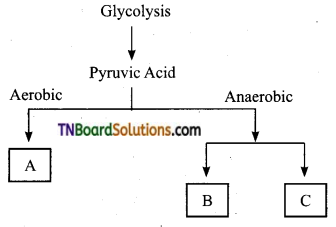
Answer:
A = Acetyl Coenzyme A
B = Ethyl alcohol.
C = Lactic acid.
![]()
Choose the correct answer.
1. Which of the following is NOT a respiratory substrate in floating respiration?
(a) Carbohydrate
(b) Fat
(c) Organic acids
(d) Protein
Answer:
(d) Protein
2. The term respiration was coined by
(a) Pepys
(b) Calvin-Benson
(c) Meyerhoff
(d) Karl Lohman
Answer:
(a) Pepys
3. Amount of energy released when an ATP molecule is hydrolysed is …………
(a) 2.7 kcal
(b) 7.3 kcal
(c) 2.8 kcal
(d) 6.5 kcal
Answer:
(b) 7.3 kcal
4. ………… is called as the universal energy currency of the cell.
(a) ATP
(b) GTP
(c) UTP
(d) AMP
Answer:
(a) ATP
5. Which step is irrelevant with respect to aerobic respiration?
(a) Glycolysis
(b) Pyruvate oxidate
(c) Fermentation
(d) TCA cycle
Answer:
(c) Fermentation
![]()
6. Anaerobic respiration occurs only in …………
(a) Mitochondria
(b) Golgi bodies
(c) Nucleus
(d) Cytoplasm
Answer:
(d) Cytoplasm
7. In glycolysis, Glucose is phosphorylated to glucose-phosphate by the enzyme ………….
(a) Aldolase
(b) Phosphofructo isomerase
(c) Hexokinase
(d) Exolase
Answer:
(c) Hexokinase
8. Glucose is a ………….. carbon compound.
(a) Six
(b) Five
(c) Three
(d) Four
Answer:
(a) Six
9. Which of the following step is common in both aerobic and anaerobic respiration?
(a) Pyruvate oxidation
(b) Glycolysis
(c) ETC
(d) TCA cycle
Answer:
(6) Glycolysis
![]()
10. Net gain of ATP’s at the end of glycolysis is ………….
(a) 2
(b) 4
(c) 6
(d) 0
Answer:
(a) 2
11. Which statement is NOT – correct in concern with glycolysis?
(i) Preparatory phase is also called the hexose phase.
(ii) Pay off phase is also called the hexose phase.
(iii) Two ATP’s are consumed in the preparatory phase.
(iv) Glycolysis is also called EMP pathway.
(a) Only (i)
(b) Only (ii)
(c) (iii) and (iv)
(d) Only (iii)
Answer:
(b) Only (ii)
12. Pyruvic oxidation occurs in ……….
(a) Cytoplasm
(b) Mitochondrial matrix
(c) Inner membrane of mitochondria
(d) Both cytoplasm and mitochondrial membrane
Answer:
(b) Mitochondrial matrix
13. Kreb’s cycle is ……… in nature.
(a) Anabolic
(b) Catabolic
(c) Amphoteric
(d) Amphibolic
Answer:
(d) Amphibolic
![]()
14. F1 particles are also referred as ……….
(a) Polysomes
(b) Oxysomes
(c) Mesosomes
(d) Liposomes
Answer:
(b) Oxysomes
15. On oxidation in mitochondrian one molecule of NADH2 yield …………. ATP’s.
(a) 2
(b) 4
(c) 3
(d) 1
Answer:
(c) 3
16. Which cell organelles are referred as “powerhouses”?
(a) Golgi bodies
(b) Endoplasmic reticulum
(c) Nucleus
(d) Mitochondria
Answer:
(d) Mitochondria
17. Identify the electron transport chain inhibitors prevent e– flow from cytochrome a3 to O2.
(a) 2, 4 DNP
(b) Cyanide
(c) Oligomycin
(d) Rotenone
Answer:
(b) Cyanide
![]()
18. Pick out the correct statements.
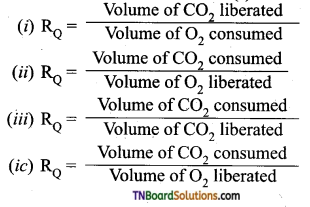
(a) Only (i)
(b) Only (b)
(c) Both (i) and (iii)
(d) Both (b) and (iv)
Answer:
(a) Only (i)
19. Respiratory quotient of glucose in presence of oxygen is …………
(a) Unity
(b) Infinity
(c) Less than unity
(d) Zero
Answer:
(a) Unity
20. Number of CO2 molecules generated in Kreton cycle is
(a) 2
(b) 4
(c) 6
(d) 8
Answer:
(b) 4
21. Calculate the respiratory quotient from the following equation
C4H6O5 + 3O2 → 4CO2 + 3H2O + Energy
(a) Unity
(b) More than unity
(c) Less than unity
(d) Zero
Answer:
(b) More than unity
22. Identify the wrong statement regarding fermentation.
(i) Fermentation can also be called anaerobic respiration.
(ii) In anaerobic respiration, O2 is not evolved.
(iii) Sargassum undergoes anaerobic respiration.
(iv) In anaerobic respiration, CO2 is evolved.
(a) Only (iv)
(b) Only (ii)
(c) Only (iii)
(d) Both (ii) & (iv)
Answer:
(c) Only (iii)
![]()
23. ………. is an alternate way for glucose break down.
(a) Glycolysis
(b) Fermentation
(c) Respiration
(d) HMP shunt
Answer:
(d) HMP shunt
24. …….. is used for the synthesis of anthocyanin.
(a) Ribulose
(b) Erythrose
(c) Sedoheptulose
(d) Xylulose
Answer:
(b) Erythrose
25. Mention the optimum temperature for respiration?
(a) 25°C
(b) 30°C
(c) 26°C
(d) 28°C
Answer:
(b) 30°C